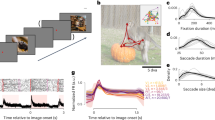Abstract
SINCE 1878 when Kühne reported the faint bluish fluorescence of the dark adapted retina and its brighter greenish supplementation when the visual pigments were bleached1, these observations have been little used or extended2,3. Early in 1966, during another investigation, one of us noticed the interesting microscopic autofluorescence pattern shown in Fig. 1. This led us to similar observations on a number of retinas. Pieces of dark adapted retina (4 × 4 mm) placed receptor side up in a depression slide in Ringer's solution were examined in a fluorescence microscope equipped for infrared viewing; ultraviolet excitation was provided by a GE 1000 W AH6 Hg lamp plus a B and L 250 mm grating monochromator set to 366 nm giving a band pass of about 13 nm. Abbe illumination was provided through a 10 × 0.20 NA achromatic objective in place of a condenser. To avoid bleaching, the microscope was focused (at a magnification of × 50–100) using infrared illumination before exposure to ultraviolet light was begun. Several layers of ‘Wratten 2C’ filter served to block transmission of ultraviolet light to the observer's eye and film plane. Photography was performed directly through a 16 × 0.4 NA or a 25 × 0.60 NA objective without an ocular in order to maximize photon flux density at the film plane, thus minimizing exposure. Polaroid type 47, ASA 3000, black-and-white film and Kodak Ektochrome, ASA 125, colour film were used. A photographic shutter in the illumination optics could be opened for viewing fluorescence or to provide appropriate exposure times for photography. The shutter was closed at all other times to minimize ultraviolet bleaching of visual pigment or photo-inactivation of fluorescence. Photographic exposure times ranged from 2 s to 30 s.
This is a preview of subscription content, access via your institution
Access options
Subscribe to this journal
Receive 51 print issues and online access
$199.00 per year
only $3.90 per issue
Buy this article
- Purchase on Springer Link
- Instant access to full article PDF
Prices may be subject to local taxes which are calculated during checkout
Similar content being viewed by others
References
Kuhne, W., On the Photochemistry of the Retina and on Visual Purple (edit. by Foster, Michael) (Macmillan, 1878).
Denton, E. J., Proc. Roy. Soc., B, 150, 78 (1959).
Hagins, W. A., and Jennings, W. H., Disc. Farad. Soc., 27, 180 (1959).
Chance, B., and Baltscheffsky, H., J. Biol. Chem., 233, 736 (1958).
Liebman, P. A., and Entine, G., Vision Res., 8, 761 (1968).
Crescitelli, F., Ciba Symp. on Color Vision, 301 (J. and A. Churchill, Ltd, 1965).
Guzzo, A. V., and Pool, G. L., Science, 159, 312 (1968).
Author information
Authors and Affiliations
Rights and permissions
About this article
Cite this article
LIEBMAN, P., LEIGH, R. Autofluorescence of Visual Receptors. Nature 221, 1249–1251 (1969). https://doi.org/10.1038/2211249a0
Received:
Revised:
Published:
Issue Date:
DOI: https://doi.org/10.1038/2211249a0
This article is cited by
-
Fluorescence of blowfly metarhodopsin
Biophysics of Structure and Mechanism (1983)
Comments
By submitting a comment you agree to abide by our Terms and Community Guidelines. If you find something abusive or that does not comply with our terms or guidelines please flag it as inappropriate.



